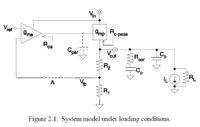ken_cn
Member level 2
Hi all,
I am doing the ac simulation of a LDO. I used the method which was mentioned in the thesis of Rincon Mora (see the following Fig.)
But in my simulation I found that the output voltage is changing in defferent load conditions, and sometimes even at minus values. So I think the on-res of the pass element is not make sense.
My question is how to maintain the output voltage at the value it was used (i.e. 3v or 5v)?
Thanks
 !
!
I am doing the ac simulation of a LDO. I used the method which was mentioned in the thesis of Rincon Mora (see the following Fig.)
But in my simulation I found that the output voltage is changing in defferent load conditions, and sometimes even at minus values. So I think the on-res of the pass element is not make sense.
My question is how to maintain the output voltage at the value it was used (i.e. 3v or 5v)?
Thanks
 !
!